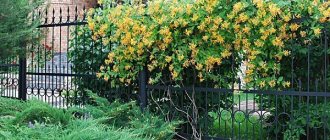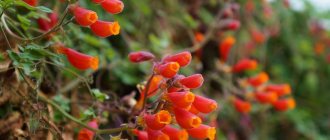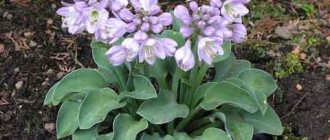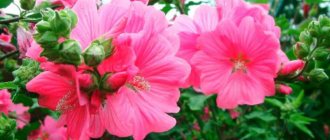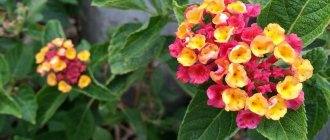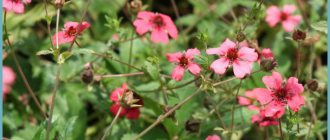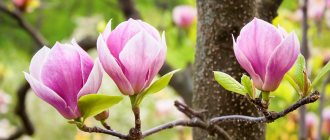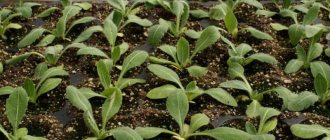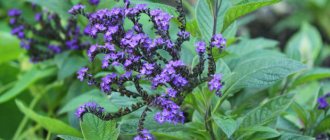A tropical flowering crop, a representative of the Acanthus family, Thunbergia has about 150 species, which in turn became the ancestors of decorative varieties. In its natural habitat, both shrubs and vines are found. Used in ornamental gardening and grown as a houseplant. It propagates vegetatively and generatively; growing thunbergia from seeds is the most common method; mostly thunbergia in gardens is an annual plant.
Description of thunbergia
A flowering plant, found in African and Asian tropical forests as an annual and biennial plant, it blooms throughout the year. Thunbergia is a heat-loving crop; it cannot tolerate even a slight drop in temperature, so it does not overwinter in temperate climates.
In the central zone, thunbergia is grown as an annual plant and propagated only by seeds. In the south, biennial varieties can also be planted, but the next season after winter, thunbergia loses its decorative effect and gains green mass due to flowering. Shrub forms are rare in gardens; liana-like varieties are mainly grown.
Thunbergia, planted on the site, quickly forms a strong root system and produces 3-5 highly branched stems. It grows quickly, in 1.5 months the shoots reach up to 7 m. The crown is thick, dense, covered with flowers of various colors:
- yellow;
- white;
- red;
- pink.
The flowering period is long - from early July to September. Seed collection - in early October.
The external characteristics of thunbergia are as follows:
- The main stems are thin dark gray, the side shoots are light ash.
- Numerous leaves are oval, lobed or entire, rich green in color, formed oppositely. A leaf plate with a relief surface due to randomly located small veins. The edges are smooth or jagged, the petioles are short and thick.
- Zygomorphic flowers are bisexual; there are varieties with single flowers and inflorescences. Petals - 5 pcs., they are fused at the base, giving the flower a funnel shape. They are formed from axillary leaf buds. The flowers are large – up to 4-5 cm.
- The fruit is a capsule with two nests, the seeds are light brown in diameter 3-4 mm with an uneven surface.
Important! Thunbergia flowers and juice have medicinal properties.
Botanical description
The thunbergia plant can be a vine or shrub with whole heart-shaped or ovate, as well as lobed opposite leaves with soft pubescence from 2.5 to 10 cm in length, in some species the edges of the leaves are serrated. Funnel-shaped beautiful thunbergia flowers up to 4 cm in diameter on long stalks, solitary or collected in inflorescences, have different colors - white, blue, indigo, violet, lilac, purple, yellow, orange or brown. There is even Thunbergia red. In some species and varieties, the flowers emit a strong aroma. Thunbergia blooms from July to the end of September.
In nature, Thunbergia is a perennial plant, but in our climate, growing Thunbergia in open ground as a perennial plant is impossible due to our cold winters, so Thunbergia climbing is cultivated as an annual plant and is often used for vertical gardening, since if there is support it grows up to two meters in height. height. But ampelous thunbergia is successfully grown as a perennial at home or in greenhouse conditions.
Types and varieties of thunbergia
There are more than 100 wild species in nature, but only a few of them are grown for decorative landscaping. Most of them formed the basis for breeding varieties. The popular varieties have earned popularity among gardeners due to their intense flowering and ease of agricultural technology. Below are the most common species and cultivars of Thunbergia in the central zone and the European part of the Russian Federation.
Winged
Thunbergia alata is a species crop grown as an annual plant from seeds. Gardeners are better known as black-eyed Suzanne. A tall liana-like plant with a flowering period of July and September. The most common type of thunbergia, which has a large number of cultivars and varietal groups.
A distinctive feature of the species is a black fragment in the center of single flowers. The maximum growth of the vine is up to 2.5 m. The flowers are orange or dark yellow, large. The leaves are paired, heart-shaped, with smooth edges, pubescent below.
Several popular varieties.
- Blushing Sussie is a thunbergia with soft pink, light brown flowers.
- African Sunset is a variety of bright terracotta color.
- Sussie Orange - the name fully corresponds to the color of the petals.
- White Sussie is a vine with white flowers.
The species of winged Thunbergia and its varieties with a delicate, sweet aroma are grown in regions with cold climates and in the south.
Related
The decorative form of the species is grown in open areas and indoors. Thunbergia genus adorns botanical gardens throughout Europe; it is the largest-flowered representative of the crop. Lina grows up to 4.5 m, the crown forms a thick green mass, completely covered with 9-12 cm flowers.
The leaves are oval, elongated, with a pointed tip, glossy with wavy edges. The flowers are blue or purple with a yellow fragment in the center.
A common variety of thunbergia used in gardens is Grandiflora violet.
The flowers of the variety are dark purple, solitary, located in the leaf axils, growing with a downward slope. Flowering period – June, August. Mainly grown in areas with warm climates.
Fragrant
Thunbergia fragrant is an annual liana up to 6 m tall, one of the early varieties, the crop is grown in the middle zone. It begins to bloom at the end of May, the seeds are collected in September.
The leaves of the plant are lanceolate, glossy, hard with smooth edges and a pointed tip. The flowers are large - 5 cm, pure white with an orange central part. Varieties of the species are Thunbergia smooth and Thunbergia clothed. They differ from the main type in the central part of the flower; in varieties it is completely white. The name of the species is associated with a persistent pungent odor during flowering.
Attention! Varieties with a high shade tolerance are well suited for horizontal gardening; the crop is also grown indoors.
Large-flowered
A highly decorative climbing plant with massive dark green leaves. The leaf blade is up to 20 cm, broadly oval, tapering upward, the edges are coarsely toothed.
Flowers - 9 cm, blue or dark blue with a white or yellow throat. Petals are oval, pointed. Collected in inflorescences, in the form of a brush, 3-5 pieces each. Thunbergia grandiflora blooms in July and September. The liana grows up to 2 m. It is grown in gardens in the Moscow region and Central Russia.
Erect
Thunbergia erecta is grown as a stationary plant. The culture is found in greenhouses, residential premises, offices, and winter gardens. Refers to perennial evergreen shrubs.
The stems are vertical – 1-1.2 m long. The leaves are sessile, fused in 3 pieces, oval, dark green. Flowers – 8 cm, bright blue, solitary. The inside of the tube is painted yellow with white trim. The petals are round with wavy edges. If grown indoors while maintaining humidity at 60-75%, it blooms all year round.
Mysore or Mizoren
An Indian representative of culture is radically different from his species. In its natural environment, it is an evergreen vine with drooping inflorescences reaching up to 1 m in length. Thunbergia mizorenica is one of the few varieties that are used in gardens as a perennial plant.
The leaves of Thunbergia Mysore are elongated, thick, bright green with white spots along the top. The flowers are densely arranged on an inflorescence of a form unusual for the culture. The color is two-tone, the lower part is terracotta, the petals, fused in the shape of a bowl, are bright yellow. A variety with a delicate aroma, the crop blooms from June to September, grown as a decorative element in the south.
Features of thunbergia
The thunbergia flower is a prominent representative of the acanthus family. The liana is native to tropical regions of Africa, South Asia and Madagascar. In total, about 200 varieties of bush are known. The plant got its name in honor of the Swedish naturalist Carl Thunberg, who studied the flora of South Africa and Japan.
Thunbergia in landscape design
Characteristics and description of the plant
Thunbergia can be a perennial or an annual. It can be a vine growing up to 10 meters in length or a shrub up to 8 meters high. The leaves have soft pubescence, jagged edges and a heart-shaped shape. The blossomed buds reach a diameter of 4 cm and are funnel-shaped.
Additional Information! Thanks to the dark core, the flower is called Black Susanna in Europe.
Planting thunbergia seeds for seedlings
Thunbergia is grown as seedlings in temperate climates. In the south they practice direct planting of seeds into the soil. The plant does not tolerate even a minimal drop in temperature, and also responds poorly to the difference between day and night indicators. Before flowering begins, the duration of the growing season is within 2 months. To speed up the onset of flowering, Thunbergia is grown as seedlings.
When to plant thunbergia seedlings
The seeds of the crop can be sown in spring or late summer. Spring planting depends on the weather conditions of the region. In areas with a cold climate, seeds are planted in April; the optimal spring temperature for the plant will not be restored until the end of May; by this time the seedlings will have become sufficiently strong and will quickly begin to grow in the area. In the central regions and closer to the south, seeds are sown in February.
It is necessary to create the necessary conditions for seedlings in winter:
- lighting – 16 hours;
- temperature – no higher than +200 C;
- humidity – 80%.
Seeds can be planted at the end of August. Autumn thunbergia will bloom in June, will remain decorative until September, and the seeds will also ripen faster. This method is used to grow thunbergia in the European part.
Preparing soil and seeds
The crop seeds are sorted and undamaged large material is selected. Then placed in a solution of 5% manganese for 2 hours to prevent fungal infection. Before placing in the soil, the seeds are dipped in the preparation "Epin", the time and concentration are indicated in the instructions.
For full growth, seedlings need nutritional composition. The planting mixture is prepared from peat, organic matter and topsoil in equal proportions, adding 2/10 of Agroperlite, the natural material absorbs moisture well and releases moisture back.
Sowing
Before planting the seeds, the substrate is calcined, allowed to cool and poured into a container: plastic glasses, a container or a wooden box. Planting seeds:
- The substrate is watered abundantly.
- Make furrows 0.5 cm deep.
- Place the seeds and cover them.
- The top of the container is covered with film.
Advice! Seeds do not need lighting to germinate; containers can be placed anywhere at room temperature.
After 2 weeks, young shoots will appear, the film is removed.
Seedling care
Containers with sprouted seeds are placed in a room with a temperature of +18-+200 C, providing 16-hour lighting. Recommended care:
- After the formation of the 3rd leaf, the crowns are pinched so that the plant branches well.
- Do not allow the soil to dry out.
- Spray the seedlings in the evening and in the morning.
- After the formation of the 5th leaf, the seedlings are planted in separate containers. If the seeds are sown in glasses, this measure is not necessary.
After transplantation, seedlings are grown, including in agricultural technology fertilizing with complex mineral products and periodic hardening of planting material.
Growing thunbergia from seeds
How to sow seeds
Seed propagation of thunbergia occurs in late winter or early spring. The seeds are treated with epin or fumar and sown in containers with moist soil consisting of turf soil, peat and sand (or leaf soil, sand and humus) in equal proportions, sprinkled with a thin layer of soil, which is carefully moistened. To create a greenhouse effect, the crops are covered with glass or film and placed on a warm, well-lit windowsill, where direct sunlight does not reach. It is very important to ensure that the soil is slightly moist at all times.
- Caring for cannas after flowering
The temperature for successful seed germination is 22-24 ºC. If all conditions are met, the seeds will begin to germinate within a week, and then the coating can be removed.
Seedling care
If the seedlings sprout densely, then when two true leaves appear, they need to be plucked or thinned out, leaving the strongest specimens in the container. When the seedlings reach a height of 12-15 cm, in order to enhance branching, the tops of the seedlings are pinched. If you want a powerful and dense green mass, feed the seedlings once a week from the moment of picking with nitrogen-containing fertilizer, but if you are hoping for lush and long-lasting flowering, do not fertilize the seedlings at all. For those who do not want to bother with picking thunbergia, it is better to sow it not in containers or boxes, but in peat cups with three seeds each.
Transplanting thunbergia into open ground
Seedlings grow very quickly; if the material is grown from the end of summer, the plant is placed on the site with the first buds. Therefore, it is very important that the plant quickly adapts to the new environment. Thunbergia is planted at the end of May and covered at night until mid-June. When the weather becomes stable, there will be no need for shelter.
For the crop, an area in partial shade on the western side is allocated; the vine is not drought-resistant; humidity is more important for it, not the sun. The plant should not be grown in acidic or heavy soils; the soil should be light, aerated, and neutral.
Landing algorithm:
- The area is dug up, superphosphate, compost and ash are added.
- The recesses are made according to the volume of the root.
- The distance between seedlings is 0.5 m.
- The seedling is covered with soil and watered.
After planting, a trellis is installed, taking into account that the vine grows not only upward, but also to the sides.
Reproduction
Thunbergia propagates by cuttings and seeds.
They are mainly propagated by cuttings if they keep the flower at home. When pruning, the cuttings are rooted in a sand-expanded clay mixture. Keep at a temperature of at least 22-25°C, water regularly and provide good diffused lighting. After rooting and the appearance of the first new shoots, the top is pinched and weak stems are removed.
In regions with temperate climates, the garden is grown mainly from seedlings. When is the best time to plant plants depends on the region and climatic conditions. Seed material remains viable for 1-2 years. Usually seeds are sown in late February - early April. It should be taken into account that the vine grows quite quickly, and flowering begins 3-4 months after sowing.
Planting seeds
The seed material is treated with a biogrowth stimulator (Bioglobin, Epin, etc.), since germination is not very high. A common container, but better separate containers - plastic or peat cups with drainage holes are filled with a substrate of turf soil, humus and sand in proportions 2:2:1. Seeds, 3-4 per pot, are planted to a depth of 0.5 cm. Sprinkled on top and irrigated with a spray bottle. The container is covered with polyethylene or glass and placed in a bright and warm place. The optimal temperature for germination of seedlings is 20°C and above. The mini-greenhouse is ventilated daily and moisture is removed.
Sprouts appear after 2-3 weeks. It is recommended to remove weak shoots or pick. Young vines are protected from direct sunlight and watered with soft water. On warm days, seedlings can be placed on a covered, well-lit loggia.
Sprouts 15 cm high with 3-4 pairs of young leaves are ready for planting. If the time for planting has not yet come, you need to carefully, without damaging the root system, transplant the bushes into larger containers and place supports so that the shoots do not begin to curl around themselves.
They are planted in open ground at the end of May - beginning of June, when the likelihood of a return of spring frosts has passed and the temperature will not drop 10-15 ° C. When planting, it is recommended to pinch the top to stimulate the growth of side shoots.
With an excess of nitrogen fertilizers, the bushes produce a thick green mass, and flowering becomes sparse.
Rules of care
Preserving the decorative appearance of the crown is not difficult for the gardener. The crop is grown with normal care; the agricultural technology of the vine is the same as that of all flowering plants. Caring for thunbergia is as follows:
- To supply oxygen, the soil is periodically loosened and weeds are removed along the way.
- To prevent the buds from falling off and the leaves from turning yellow, water after 2 days.
- In dry weather, sprinkling is carried out in the evening.
- If necessary, trim dry areas.
- Direct the shoots in the right direction.
During flowering, feed with organic matter and superphosphate. Fertilize once every 2 weeks, alternating fertilizers. Remove flowers that have reached the end of their growing season.
Growing and care
Basics and features of growing thunbergia
If we talk about planting in open ground, then the place should be bright, but protected from the midday sun.
Important! The presence of direct sunlight for a long time and their constant influence on the surface of thunbergia can lead to burns and a decrease in decorative appearance.
Planting should also be avoided in places where groundwater is too close. If there is no other choice, it is better to create a high flower bed, while organizing high-quality drainage.
The last requirement for planting conditions is protection from strong drafts. Not only is it a heat-loving plant, but it has tender shoots and flowers.
Planting thunbergia seeds
Thunbergia seeds are sown in early spring or late February and before that they should be treated with growth stimulants.
Reproduction occurs, in fact, by seedlings and the seed is initially placed in prepared soil with which the containers are filled. The soil is prepared in equal parts from peat, sand and turf soil. Everything except sand can be replaced with humus and leaf soil.
The seeds are laid out on the surface and sprinkled with a thin layer of soil, after which careful watering is carried out using a sprayer. Next, I cover the containers with film to create a microclimate, and place them on a windowsill with good lighting, but with protection from strong sun.
Important! The soil in pots should be regularly moistened and ventilated. For the speedy emergence of seedlings, you need to maintain a temperature within 22-24 degrees. These conditions promote germination as early as the seventh day. From this moment the cover is removed.
Further care of seedlings
With increased density of seedlings, after the appearance of two leaves, it is necessary to remove the weakest specimens. At this time, picking is already possible.
To increase the density of the bush in the future, pinching is carried out at the seedling stage, when it grows by 12 cm. To increase the thick green mass, from this moment you can start applying fertilizers once a week, using complexes with nitrogen.
For abundant and long flowering, thunbergia does not need to be fed.
In order not to pick the seedlings, initially sowing can be done in small peat cups, at the rate of 3 seeds for each.
Transplanting seedlings into open ground
The ideal time for seedlings to be transferred outside is to ensure that there are no night frosts. As already mentioned, you need to choose an area with light shading in sunny times, protected from strong drafts.
The planting site should contain neutral acidic soil rich in nutrients and lime. All this is done while preparing the area for planting plants.
Based on further goals, you need to choose the distance between seedlings. To create a wall, the distance should be up to half a meter. Before this, you need to place supports if there is no, for example, a fence with a mesh along which an adult plant will climb.
Interesting! Since thunbergia is a vine, it can curl not only upwards, but also to the sides.
After planting the plant in the holes, it is watered. Flowering will occur on the hundredth day after the first pinching.
Creating conditions
Temperature for growing indoor thunbergia
With the onset of spring and before the arrival of autumn, the ideal temperature will be between 20-25 degrees. It is important to regularly ventilate the room in which the flower is located, but not to create drafts.
With the beginning of October, the temperature in the room drops to 13-16, which means the onset of a dormant period for the plant and a slowdown in growth.
When growing at home, the pot can be placed on the balcony and loggia, if this is not the sunniest and windiest side.
Thunbergia watering regime
Caring for thunbergia involves creating the necessary conditions, including high-quality watering. You need to moisten the soil regularly, but in moderation. It is better to focus on the top layer, which should dry.
As flowering begins, watering becomes a little more abundant. If there is a lack of moisture, the plant will simply begin to shed buds and leaves. This also applies to the very hot period of summer. At this time, watering should be done a little more often. In addition, you can place a container of water nearby to increase the percentage of air humidity. In the evenings, artificial sprinkling and spraying can be carried out.
Fertilizer schedule for thunbergia
It is permissible to feed thunbergia from mid-spring to early autumn only a couple of times a month, no more. It is better to use complex formulations for flowering plants. The solution is applied some time after watering.
You can stimulate the growth of green mass in the spring by applying nitrogen-based fertilizer.
Important! Nitrogen must be excluded from fertilizers before buds begin to set, otherwise their quantity will be minimal.
Pruning, replanting
Formation of the crown of a climbing plant
For an outdoor plant, only pinching at the initial stages of growth is important for good branching. When grown at home, thunbergia is a perennial, so after 2 years the shoots are cut off by a third. This allows you to renew the culture and stimulate the growth of young shoots.
Withered buds should be removed using any growing method in order to maintain the decorative appearance of the crown.
Climbing thunbergias can be grown indoors and outdoors in hanging flowerpots, allowing the branches to trail down. When growing vertically, supports, a net or a fence are installed behind.
Important! To preserve decorativeness, you need to cut not only wilted flowers, but also dry and broken branches. At times, long shoots are directed by the grower in the desired direction to form a beautiful flower fence.
Rules for transplanting indoor thunbergia
Thunbergias growing outdoors do not require replanting because they grow as an annual plant.
Growing indoors requires regularly changing the pot. For the winter dormant period, the shoots are cut off to 6 buds, and the container is placed in a cool place. To prevent the soil from drying out during this time, it needs to be slightly moistened once every 2-3 weeks.
With the arrival of spring, a planned replanting of the plant is recommended, and the new container should be 5 cm larger than the previous one in both height and width. It is ideal to carry out transplantation using the transshipment method.
To fill the bottom and side space between the walls and the old earthen ball, light and loose soil is used.
This composition can also be taken for the initial planting of thunbergia:
- part of leaf and turf soil or 2 parts of one of them;
- half peat;
- half sand.
When replanting, it is worth cutting off any dried or thin shoots that appear.
How to collect thunbergia seeds?
Seed pods form on the plant as the buds fade. If they are not collected on time, the ripe fruits open on their own and self-seeding occurs.
After cutting the seed pods, they are placed in a dry room and laid out on a flat surface. While they are drying, the room should be regularly ventilated. After this, the fruits are opened manually and the seed material is removed, after which they are poured into cardboard boxes or paper bags for further storage.
Important! With proper storage and indoor microclimate, you can grow thunbergia from seeds of one collection for about two years in a row. Then you will need to collect fresh material.
Diseases and pests
If thunbergia is grown following the requirements of agricultural technology, it does not get sick. Fungus on stems and leaves is a very rare phenomenon; the infection affects the crop in the case of a cold rainy season. Problem areas are removed and the vine is treated with a fungicide.
With pests the situation is more complicated. They parasitize Thunbergia:
- aphid;
- spider mite;
- scale insect;
- whitefly
Prevent the appearance of pests by preventative treatment of the bush in the spring with Actellik. After 3 weeks, the procedure is repeated. When parasitic insects appear on the vine, Fitoverm is used to eliminate them.
Thunbergia care
Growing conditions
Thunbergia care is simple. The plant should be watered moderately, and from the beginning of flowering, watering should become plentiful, otherwise thunbergia will begin to shed not only buds, but also leaves. In dry summers, the plant will gratefully respond to spraying with water in the evening. Mandatory feeding is carried out during the budding period, and throughout the spring-summer season, thunbergia is fertilized monthly with liquid mineral fertilizers, observing the golden rule: everything is good in moderation. Remove weak shoots and faded flowers, and point the thunbergia in the right direction in time.
As you can see, even a beginner can plant and care for thunbergia.
- Vatochnik: growing in open ground and care
Pests and diseases
Most often, thunbergia is oppressed by spider mites, scale insects and whiteflies, and sometimes it suffers from aphids. All these pests are destroyed by spraying the plant with preparations such as Actellik and Fitoverm, and the break between treatment sessions, which can be no more than four, is a week or a week and a half. Sometimes thunbergia suffers from fungal diseases, which are treated with fungicides; the affected leaves and flowers should be removed.
It may happen that mold appears on the stems, shoots and leaves of thunbergia, this indicates that you have overdone the watering. And sparsely growing foliage indicates that you have chosen a too shady place for thunbergia - it does not have enough light.
How to collect your seeds
After ripening, the fruit capsule opens and the seeds spill out onto the ground. This feature of the plant makes it difficult to collect seeds. It is necessary to collect the fruits when the flower is in a semi-withered state. The seeds were already fully ripe, but did not spill out because the fruit shell was not completely dry. The boxes are collected, laid out on light cloth or paper, and placed in a sunny place. After drying, collect the seeds and store them in a dark, dry place. Seeds remain viable for no more than 2 years; after this period, thunbergia is not grown from old seeds; germination drops by 50%.
Reproduction of thunbergia
The plant is propagated by sowing seeds or cuttings. To propagate by cuttings, you should prepare cuttings up to 10 centimeters long, treat them with a biostimulant and plant them in a nutrient mixture consisting of peat and coarse sand. You can also use ready-made peat pots for these purposes. After this, the cuttings are covered with plastic bags or glass jars to maintain constant temperature and humidity. After three weeks, the cuttings should take root. After transplanting to a permanent place, they are pinched.
Thunbergia in landscape design
Grown in ornamental gardening, mainly liana-shaped forms of the crop. Like all climbing plants, thunbergia needs support. Here the designer’s flight of imagination is unlimited:
- The trellis is used vertically as a dividing element of garden zones.
- The arched structure will become the basis for a decorative arch.
- A crop with approximately the same flowering period, but varied flower colors. Grow by alternating colors by planting in a horizontal line to imitate a hedge.
- Used to decorate garden gazebos.
The liana is grown in flowerpots for landscaping verandas, loggias or balconies. Below are a few photos of how you can use an ornamental plant in landscape design.
Home care
Actions after purchase
You should not buy a plant in winter.
Since at this time the plant enters a dormant period, and it can shed leaves abundantly.
In winter, the flower requires special temperature conditions and careful care.
Many buyers, faced with numerous problems, throw the plant outside.
Therefore, it is recommended to buy perennials in spring or summer.
Trimming
When forming, it is necessary to remove weak stems and wilted flowers. During the growth of this representative of the flora, it is necessary to direct it in the right direction. For this purpose, supports and wires are used. Do not use rusty material. Oxidation can negatively affect the health of the plant.
Watering
The plant prefers moderate watering. But from the beginning of flowering in mid-July it increases sharply. During this period, the flower needs additional moisture.
Otherwise, this representative of the flora will begin to shed leaves and unopened buds. Flowers may begin to fall off. In hot weather, your pet loves frequent spraying from a spray bottle. The procedure is best carried out in the evening.
Transfer
Transplantation is carried out only when growing at home.
It is necessary to choose containers that are large in diameter.
The soil is used purchased for home flowers or decorative cacti.
It is important that the soil allows air and water to pass through well. Drainage made of natural stones or expanded clay is poured onto the bottom. Black soil is poured and the plant is installed. Water generously.
Important! You can fertilize with nitrogen-containing fertilizers. Application period: once every 14 days.
But during the flowering period, feeding the plant is prohibited. This will negatively affect active growth and abundant flowering.
Temperature
The plant is very thermophilic. Grows well at a temperature of 23°C.
In winter, the temperature should not fall below 15°C. The flower loves moist air. In hot weather, you can place a container with water or moistened moss next to it. The plant prefers well-ventilated areas.
Lighting
The plant loves bright natural light. Cannot stay in the sun for long. In winter, it prefers additional artificial lighting.
Landing
Planting in open ground or in greenhouses is carried out in the spring. It is important to wait out the frost. Otherwise, the plant will freeze.
For this representative of the flora, you need to find a place protected from drafts and direct sun. It is not recommended to plant the plant on the north side, since Thunbergia does not like constant shade. Grows actively in neutral soil. Loves nutritious fortified soil.
Limestone and well-drained soil are dug up in advance at the selected site. This representative of the flora must be seated at a distance of 35-40 cm from each other.
Before planting, it is necessary to install strong supports. You can use grids or twisted wires. With their help, the creeping vine will grow upward or sideways. After planting, water the area generously with a hose. Flowering occurs 30-100 days after planting.
